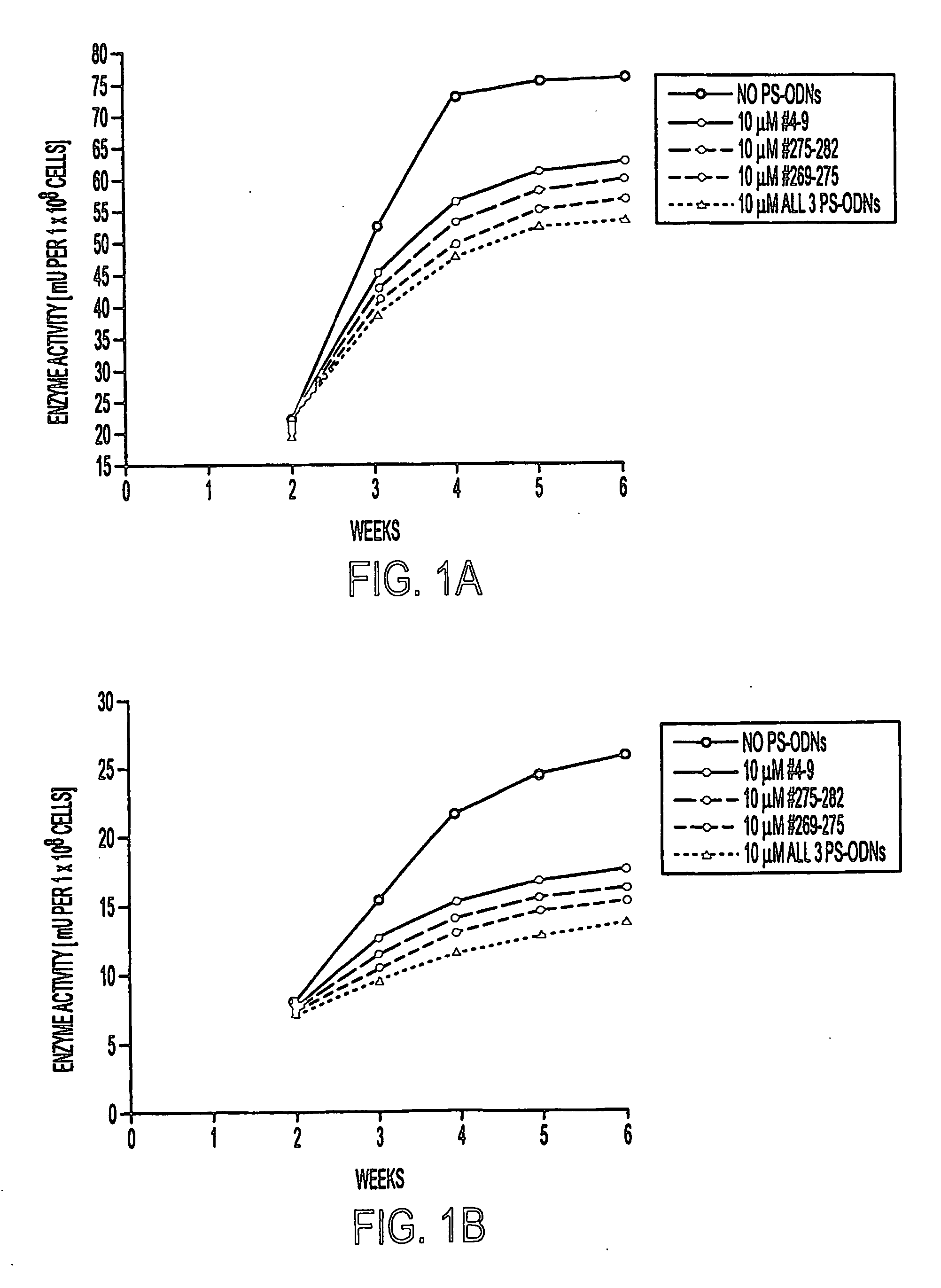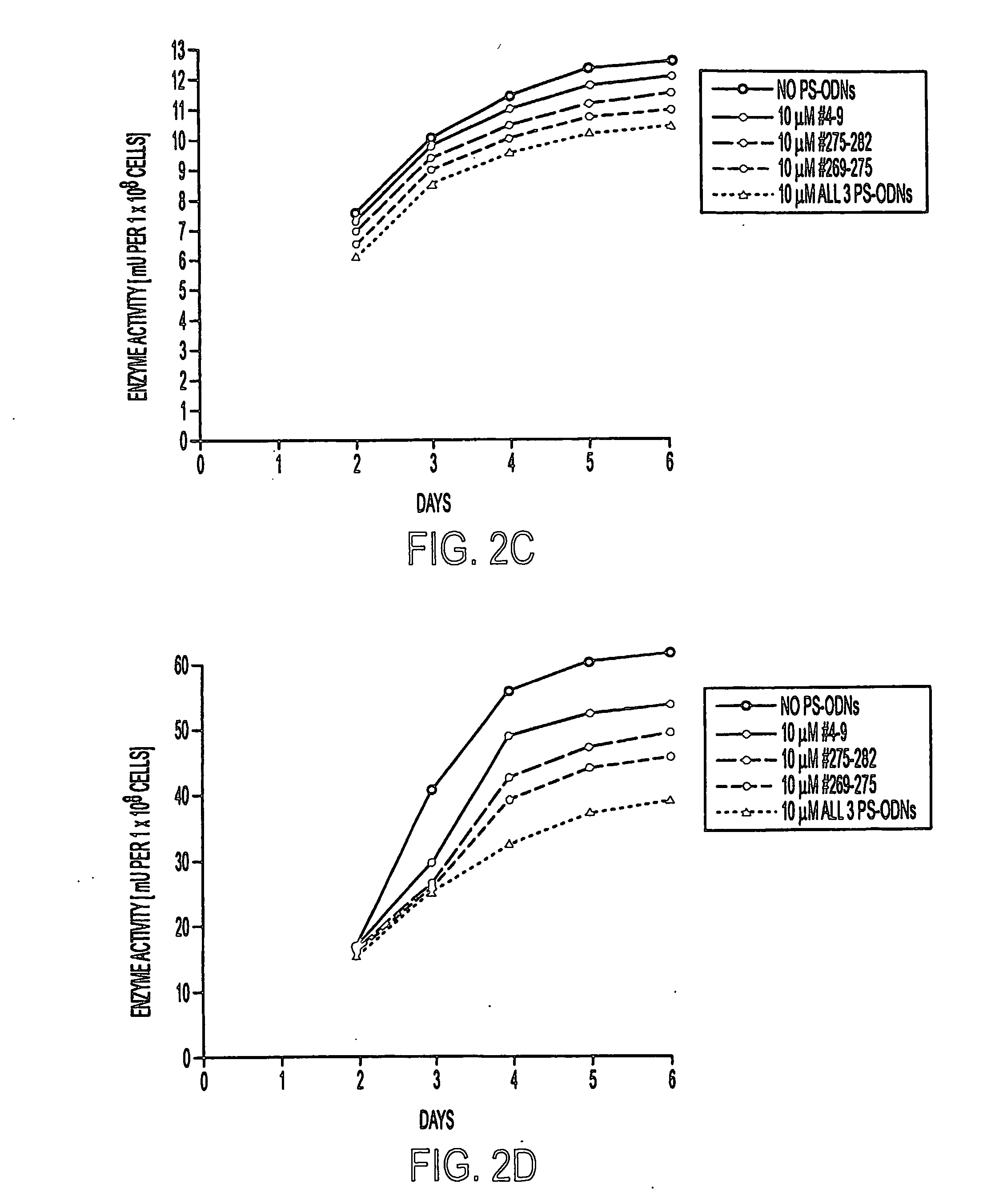Treatment of mycobacterium tuberculosis with antisense oligonucleotides
a technology of antisense oligonucleotides and mycobacterium tuberculosis, which is applied in the field of antisense polynucleotides, can solve the problems of increasing the risk of clinical tb, tb being an especially devastating complication, and the inability to eradicate tuberculosis, so as to reduce the amount of poly-l-glutamate/glutamate, reduce the amount of glutamine synthetase activity, and reduce the effect of m
- Summary
- Abstract
- Description
- Claims
- Application Information
AI Technical Summary
Benefits of technology
Problems solved by technology
Method used
Image
Examples
example 1
Bacterial Cultures
[0124]M. tuberculosis strain Erdman (ATCC 35801) and M. smegmatis 1-2c (Garbe et al., (1994) Microbiol. 140, 133-138) were cultured in 7H9 medium (Difco) supplemented with 2% glucose at 37° C. M. tuberculosis was maintained in a 5% CO2-95% air atmosphere as unshaken cultures (because of safety considerations) and M. smegmatis was maintained at ambient conditions with vigorous shaking. For studies of the effect of PS-ODNs on the bacteria, M. tuberculosis and M. smegmatis were cultured in duplicate in 1 ml, 2 ml, or 5 ml of 7H9 broth in polystyrene tubes (Fisher) or tissue culture flasks (Costar) in the presence of medium alone, PS-ODNs at final concentrations of 0.1, 1, or 10 μM, or PS-ODNs plus inhibitory and / or subinhibitory concentrations of the antibiotics amikacin (0.058, 0.58, and 5.8 μg / ml), ethambutol (0.1, 0.25, and 0.5 μg / ml), or polymyxin B nonapeptide (0.1, 0.25, 0.5 μg / ml). All antibiotics were from Sigma. The minimal inhibitory concentrations (MIC) of...
example 2
Glutamine Synthetase PS-ODN Selection and Preparation
[0125] Three target sites for the binding of the antisense PS-ODNs were chosen (Fable 1). One site, located near the 5′ end of the glutamine synthetase mRNA, corresponds to codons 4-9 of the glutamine synthetase mRNA open reading frame, starting from the first codon GTG which specifies the initiator methionine residue. The other two sites, located in the vicinity of a catalytically important histidine residue (H276), correspond to codons 269-275 and 275-282, respectively. Antisense PS-ODNs were synthesized on a 394 DNA / RNA synthesizer (Applied Biosystems) using standard phosphoroamidite chemistry. Phosphorothioate bonds were introduced by oxidation with the Beaucage thiolating reagent (Padmapriya et al., (1994) Antisense Res. Develop. 4, 185-199) and assembled PS-ODNs were purified by HPLC and lyophilized. Amikacin derivatives were synthesized by a phosphorothioate based methodology, linking the antibiotic via one of its amino gr...
example 3
Specificity of Antisense PS-ODNs for M. tuberculosis Glutamine Synthetase mRNA
[0130] To confirm the specificity of the antisense PS-ODNs, we studied their effect on the transcript of glnA1 of M. smegmatis, a closely related gene. A comparison of the M. tuberculosis and M. smegmatis glutamine synthetase genes revealed a very high degree of DNA sequence identity and an overall DNA sequence similarity of ˜70% and protein similarity of ˜80%. At the target sites, nucleotide differences between the two mycobacterial species are sufficient so as to anticipate that the antisense PS-ODNs, based on the DNA sequence of the M. tuberculosis Erdman glutamine synthetase gene, would bind only to the M. tuberculosis gene (Table 1). The aligned RNA sequences demonstrate that the target site for PS-ODN #4-9 is different in 3 nucleotide positions (5′-AAG ACG CCC GAC GAC GUC-3′ (SEQ ID NO: 1) for M. tuberculosis and 5′-AAG ACG UCG GAC GAC AUC-3′ (SEQ ID NO: 4) for M. smegmatis), the target site for PS-...
PUM
| Property | Measurement | Unit |
|---|---|---|
| concentrations | aaaaa | aaaaa |
| concentrations | aaaaa | aaaaa |
| concentrations | aaaaa | aaaaa |
Abstract
Description
Claims
Application Information
 Login to View More
Login to View More - R&D
- Intellectual Property
- Life Sciences
- Materials
- Tech Scout
- Unparalleled Data Quality
- Higher Quality Content
- 60% Fewer Hallucinations
Browse by: Latest US Patents, China's latest patents, Technical Efficacy Thesaurus, Application Domain, Technology Topic, Popular Technical Reports.
© 2025 PatSnap. All rights reserved.Legal|Privacy policy|Modern Slavery Act Transparency Statement|Sitemap|About US| Contact US: help@patsnap.com



